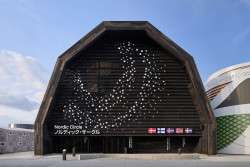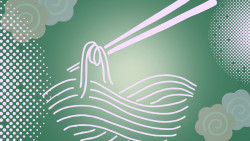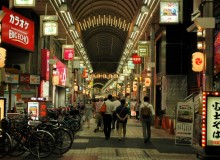
March 31, 2006
Night Of The Devil Fish
The Philippine island of Malapascua is home to sand, sun—and one very strange safari
By Metropolis
Originally published on metropolis.co.jp on March 2006

Photos by Simon Rowe
My taxi driver’s name is Jesus, or “Jez,” as he introduces himself, and he’s as slippery as they come.
Each time our beat-up Corolla stops at the traffic lights on the outskirts of Cebu City, he sticks his fat snubbed nose out the window and leers at the passing local girls. You don’t have to speak Cebuano to catch his drift. With zero class but plenty of ceremony, he then dispatches a large glob of spittle onto the pavement and turns to grin at me.
It doesn’t get much better at Ruftan House, in the heart of downtown, where Jez delivers me, irritated and over-charged but otherwise unscathed. A dozen airless cracker-box-sized rooms, positioned in perfect fire-trap formation over the restaurant kitchen, comprise this budget guesthouse for travelers.
At US$5 per night, they are what many old Asia hands might call “a cheap funeral.”
I slump onto a stool, order a Coke, and with great diplomacy ask the tall man with a feminine lisp, who introduces himself as the manager, about “alternative accommodation.”
He hands me a crumpled postcard advertising an island called Malapascua in northern Cebu. “It means ‘Unfortunate Christmas’,” he adds usefully.

White sand, blue sea, a hammock—this postcard lifts my spirits. Under the manager’s lingering gaze, and with Jez and his greasy wheels still purring outside, I know where I am heading.
Maya is a tiny fishing village that clutches the white rocks of Cebu’s northern coast, and it is here that travelers tumble out of the aptly-named D’Rough Rider, a vertebrae-crunching local bus that plies the dusty highway from Cebu City, and climb aboard a waiting outrigger bound for Malapascua, 40 minutes away.
A lick of sea spray, a whiff of the coughing diesel engine, or the cackle of huge village ladies with suspicious-smelling packages on their knees—none of these matter as a long slip of perfectly white sand, hemmed between sea and sky by raggedy plantations of coconut trees and thick beds of sea grass, come into view.
Most foreign travelers have heard of Bounty Beach, a legendary stretch of sand so white and washed by sea so clear that it is difficult to tell where one ends and the other begins. Twenty-dollar-a-night bungalows line the high-tide mark, and it is to these that most head on disembarking.
I would join them if not for a large woman named Sally. Her generous proportions barely squeeze into the small plastic chair outside her simple brick house, to which she has invited me for a rest after our boat ride. This, however, is nothing compared with the size of her enthusiasm for cooking tuna curries.
Beneath the wrappings of Tanduay Rum cartons that festoon the streets for a coming village fiesta, the 52-year-old mother of eight confides in me her most pressing concern: what to cook for dinner.
A cool sea breeze finds its way up the sandy street, and Sally’s 17-year-old-daughter, Nane, who has been sitting on the icebox, suddenly pipes up. “Devil fish [octopus]. It’s a full moon tonight, the tide will be low, and they’ll be easy to spot.”
Sally looks satisfied. “Perfect,” she said turning to me. “You catch dinner and I’ll cook it!”
Under a huge moon, I set out across the beach with Sally’s sons, Junior and David, carrying a hurricane lamp, machete and large bucket. Conditions are prime for octopus fishing. By 10pm, the entire lagoon has drained away like a huge sink unplugged, leaving vast gardens of brilliant blue staghorn and soft coral dripping above the gurgle of the outgoing tide.
The octopuses are less easy to spot. Gray, speckled and formless, these ghostly souls of the sea floor sat perched on like-colored rocks awaiting their favorite food: crab. Junior knows where to look. When he spies one, he snatches it up and clamps the squirming mass of tentacles between his teeth, biting the octopus between the eyes to break its nerve center.

Sometimes, in the octopus’ death throes, it manages to lash out with a sucker and cause a sudden yelp of pain. Out across the bay, I can hear other villagers suffering the same woes as their lanterns lurch erratically across the incoming tide.
My first catch escapes through my fingers, squirting out a cloud of ink in its wake. The next is not so lucky, as I grab it and bite squarely between the eyes, thrusting my hands down its body to prevent the tentacles from whirling up at my face.
By 11pm, our small bucket brims with writhing tentacles. Back through the village we wander, passing tables of mellow young men engulfed by empty San Miguel bottles, while old women listen to the late-night news broadcasts from their sandy lounge rooms.
Sally prods the catch satisfyingly and offers me a cold beer while she cooks it up. Too exhausted to smile, I thank her and stagger off through the coconut trees to a bungalow, a beach and a hammock that I have been too busy to enjoy.
Malapascua is located about 8km northeast of the Cebu mainland and 25km west of Leyte. The period between September and April is outside the typhoon season and offers optimum weather conditions. Philippine Airlines flies six times a week from Narita direct to Mactan-Cebu International Airport. From Cebu City’s Northern Bus terminal, take one of the D’Rough Riders or Cebu Autobus buses, which depart hourly (4am-4pm) for Maya Bagay jetty; the trip costs 65 Philippine pesos (Pp), or ¥150, one-way and takes four hours. Outrigger boats to Bounty Beach cost Pp50 (¥115) each way for the 30min ride. Less painful and faster is a taxi from Cebu City to Maya Bagay, which costs around Pp2,000-3,000 (¥4,600-¥6,850). There are several places to hang your hat on Bounty Beach: Cocobana, run by a Swiss guy, is a good one. Beachfront bungalows with a private bathroom, hammock and breakfast thrown in cost Pp960 (¥2,200) for two people. Reservations: info@cocobana.ch, http://www.cocobana.ch/bounty_us.htm or call 0063-(0)-32-437-1007; for dive safaris, check out http://www.malapascua.net/home.html
[geo_mashup_map]







